Blackened Salmon is salmon fillets brushed in butter and homemade Creole Seasoning, then pan-fried to perfection until crusty and flaky. You can serve it with a good dose of heartily, wholesome sauteed vegetables. Such a fantabulous, guilt-free, low-carb meal is super easy to make yet loaded with tons of flavor. What’s not to love?
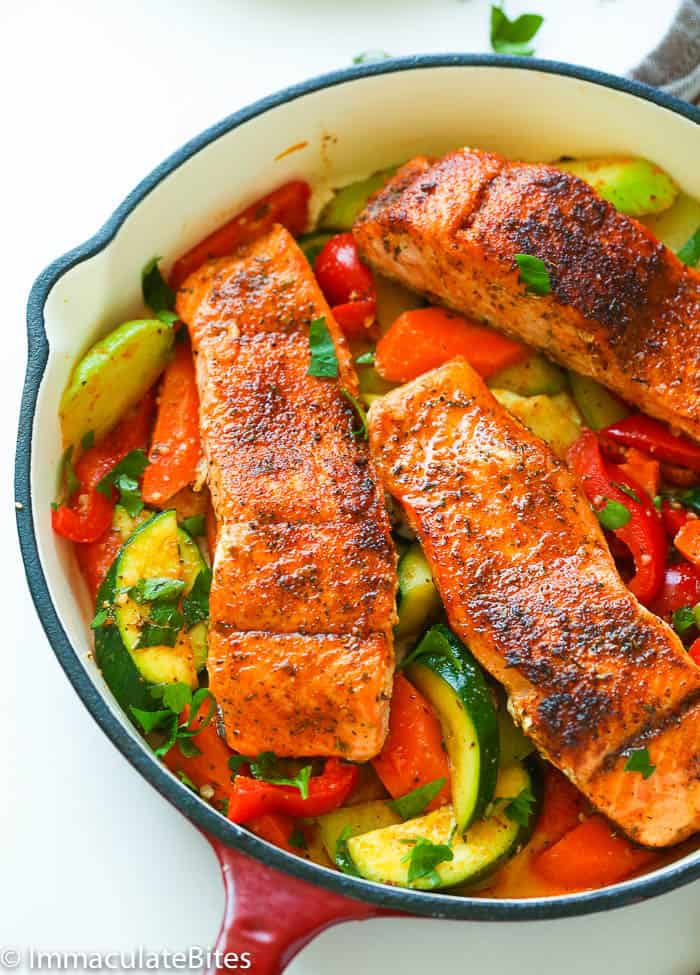
Just in case you’re wondering, blackening is a cooking technique that adds or intensifies the flavors of any dish with butter and a blend of spices.
I usually use Creole Seasoning for a more authentic Cajun flavor. This cooking technique is popular with fish or seafood and is also great with chicken.
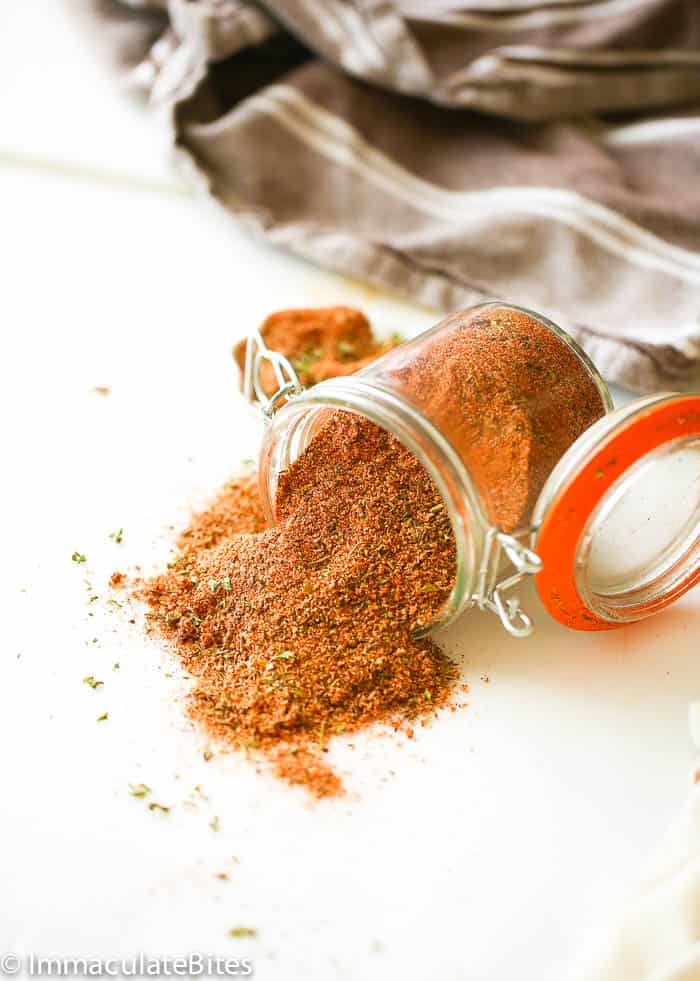
Blackened Salmon Spices and Flavors
The secret relies on good quality butter and seasonings such as Creole Seasoning or Blackened Seasoning. Amazing things happen when you dredge the salmon in seasonings and cook it in a hot skillet. Not to mention the fantastic aroma that comes along with it.
As the spices char, their flavor intensifies, and the milk solids from the butter brown to beautiful darkness, adding more delicious goodness to our already magnificent salmon.
Then the fat from the fish melds beautifully with the combination of herbs and spices. Its mild yet distinguishable taste is apparent, and the moist and flaky texture makes the dish even more delectable.
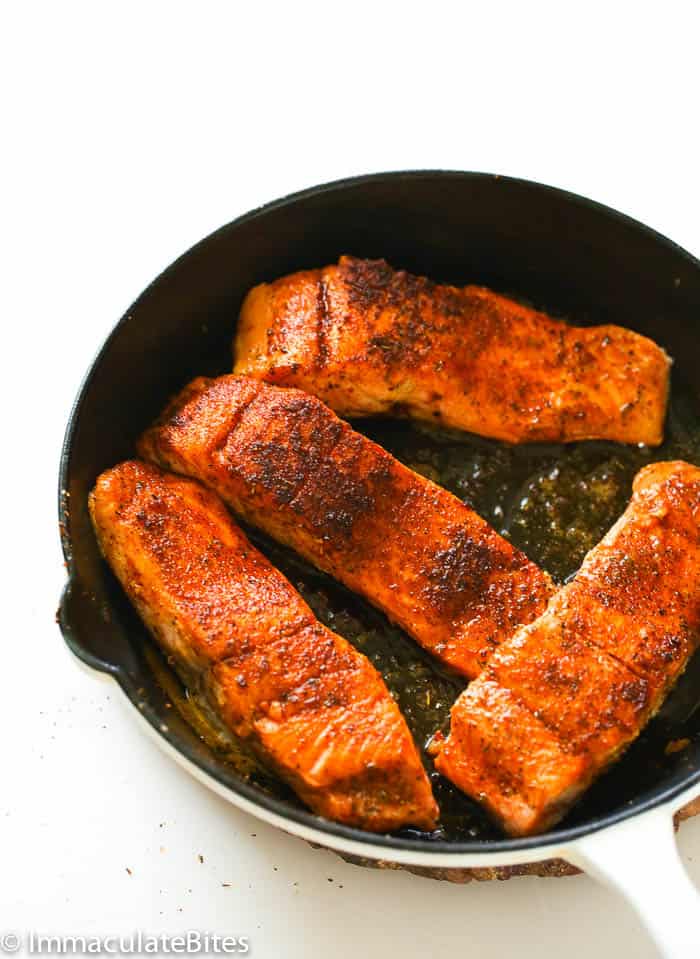
Recipe Ingredients
Aside from Salmon, I also add fresh sauteed veggies to make our dish more filling and nourishing. Feel free to add even more veggies to your liking because our recipe is easily customized. Oh yes!
For this recipe, you’ll need:
Salmon Seasoning
- Salmon Steaks – Some cooks create a dark and slightly burnt taste on the outside to actually “blacken” or char their fish, but I like my Blackened Salmon just on the toasted side. I slightly sear both sides of my salmon to create a beautiful crusty and flaky exterior while maintaining its moist and tender interior.
- Salt – I like using coarse salt because it provides a bolder flavor. Aside from flavor, it also gives our salmon a perfect crusty finish by absorbing the moisture from the outer layer of the fish.
- Butter – This ingredient keeps our salmon moist and flavorful. Butter also browns beautifully, adding to the blackened effect of our beautifully charred salmon.
- Creole Seasoning – It adds depth and rich flavor to just any dishes, plus it’s quick to put together and easily customized for personal preference. Have this Queen of all Spices right on your pantry by making it from scratch with this Homemade Creole Seasoning Recipe.
Sauteed Vegetables
- Cooking Oil – Any cooking oil works. However, if you want to add more flavor, then I highly suggest using olive oil or butter to saute our veggies. And don’t just toss used cooking oil; check out How to Dispose of Cooking Oil.
- Garlic – Nothing beats fresh minced garlic when it comes to flavor and wonderful aroma. Aah! It’s intense and inviting!
- Carrot – Well, aside from Beta Carotene, carrots are also loaded with calcium and vitamin K. Not only are they excellent for your eyesight, but they also keep your teeth and bones strong. Yaaay!
- Red Bell Pepper – I prefer red bell peppers because they are sweeter, a little fruity, and not bitter compared to the green ones.
- Zucchini – They become sweeter and richer as you cook them. Although, they can be a great addition to salad and sandwich wraps even when they are raw.
- Chayote – I love chayote! The taste is pretty mild but wonderfully sweet and sustaining. It has a nice crunch, too.
- Broth – To add more meaty goodness to our veggie dish even in the absence of red meat. However, you can trade it for water.
- Salt – Obviously, our dish wouldn’t be as amazing without the salt.
Recipe Variations
- Seasoning Swap – For a milder flavor, you may opt to use Blackened Seasoning, which is equally flavorful but not as spicy-hot as Cajun Creole Seasoning. Another option is Italian Seasoning that leans more on the herby flavor profile. At the same time, Seasoned Salt is an excellent replacement for plain salt. And for a Mexican fusion, Taco Seasoning is certainly a must-try. 😉
- Spicy Additions – Amp up the heat with the addition of cayenne pepper and pepper flakes. Or you can add a splash of Caribbean Pepper Sauce, hot sauce, or sriracha to make our Salmon recipe more exciting.
- Sweet Sensation – You can’t go wrong with sweet and spicy flavors, too. Honey and brown sugar will definitely do the trick. 😋
- Citrusy Splash – A splash of freshly squeezed lemon or lime will surely level up this fancy dish in no time. Oh yes! You can also add a few pineapple chunks to add a bright burst of flavors. Yum!
- More Veggies – Make it more nutrition-packed with lots of veggies to choose from, such as potatoes, asparagus, green beans, squash, cabbage, and a lot more!
Tips and Tricks
- Always use fresh salmon for the best results. However, frozen salmon works fine as well. Just remember to thaw it properly. Don’t let it sit on the counter for too long to prevent food-borne bacteria from accumulating.
- It’s best to work with cold salmon (but not frozen) because the butter will stick better to cold fish.
- I highly recommend using a cast-iron skillet because we’ll be cooking at a high temperature. However, if you don’t have one, stainless steel is the next best thing. You could use a non-stick pan, but it’s not the best for the high heat you need to get the perfect blackening.
- Don’t forget to preheat your pan so your salmon fillets won’t stick to it.
- Resist the temptation to flip your fish constantly. That way, you’ll achieve perfectly blackened salmon.
- You’ll know that the salmon is done when it reaches an internal temperature of 145°F in its thickest part. Or you can check if the fillets easily flake when you use a fork.
- Blanching your veggies first will retain their nutrients and bright color.
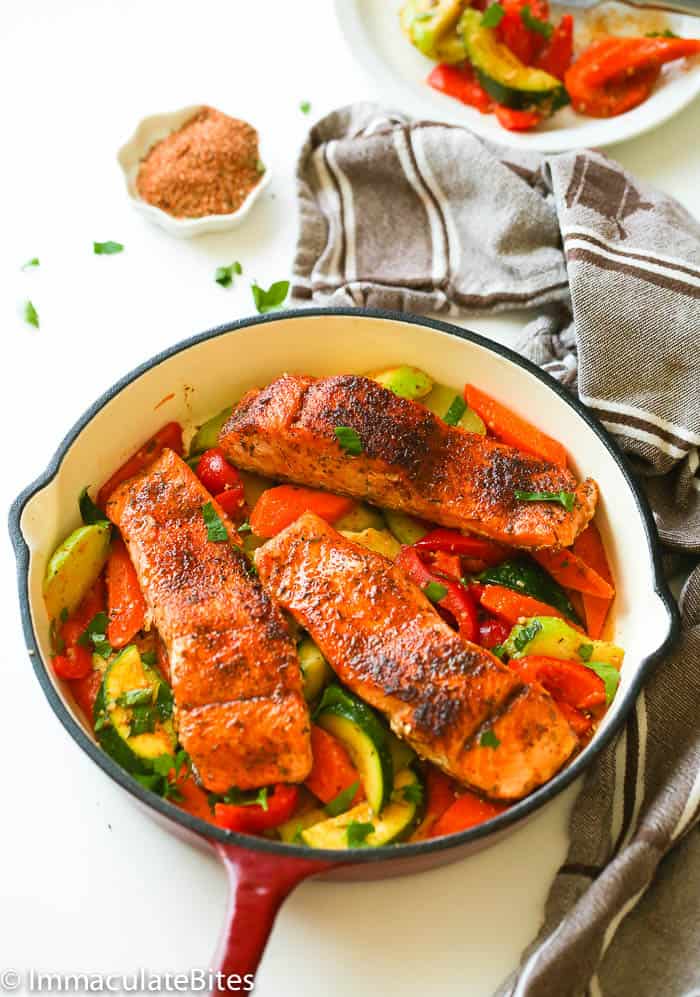
Serving and Storage Instructions
Our Blackened Salmon is absolutely best eaten straight out of the pan to enjoy its crusty and flaky skin and exterior. But in the case of leftovers:
- Storage – Any sealed containers will store leftover Blackened Salmon. However, airtight ones are still the best choice. But if you intend to freeze them, I suggest wrapping them in foil then putting them inside a freezer-safe bag while removing as much air as possible.
- Refrigerate – You can store the leftovers in the fridge for up to three days.
- Freeze – Or you can freeze them for about four months.
- Thaw – If frozen, thaw overnight in the fridge before reheating.
Note: Store the veggies in a separate container as they tend to spoil faster when stored with the salmon.
Reheating
- Stove – Reheat on the stove in your cast-iron pan over medium-low heat along with veggies. Add butter or a splash of broth to bring back the moisture.
- Microwave – Using medium power, reheat at 30 seconds to 1 minute, or until heated through.
What to do with Leftovers?
Repurpose your leftover Blackened Salmon and try these mouthwatering dishes below:
FAQs
Over the years, many have believed that charred food contains carcinogens that can be cancerous because of the acrylamide chemical released during the charring process. However, a recent study showed that the chance of consuming charred meat leading to cancer is relatively slim.
Also, it may be more likely that processed meats, such as hotdogs, sausage, and the like, are more to blame than the blackening process. In conclusion, daily consumption of blackened fish may or may not be bad for you. However, enjoying it occasionally doesn’t seem to be cause for concern.
Since Blackened Seasoning primarily contains cayenne powder, black pepper, and paprika, dishes like blackened salmon are a little spicy. However, the process of blackening mainly the result of high heat and butter. Yum! And the spiciness isn’t overpowering because added herbs such as oregano, parsley, thyme, and basil balance out the spicy level, mellowing it down. Of course, you can adjust the heat level to your preference.
The primary difference involves the use of butter, spices, and high heat. Grilled meat doesn’t follow any particular rule when it comes to marinating. It can be dry brine or wet brine or marinated in a well-seasoned liquid or dry spices, while Blackened Salmon is all about butter and spices.
In grilling, you have more control over the cooking process. On the other hand, Blackened is more challenging because, if not done correctly, it might result in bitter, burnt food. The high heat and butter lock in all the spicy flavors, creating a delicious crispy crust
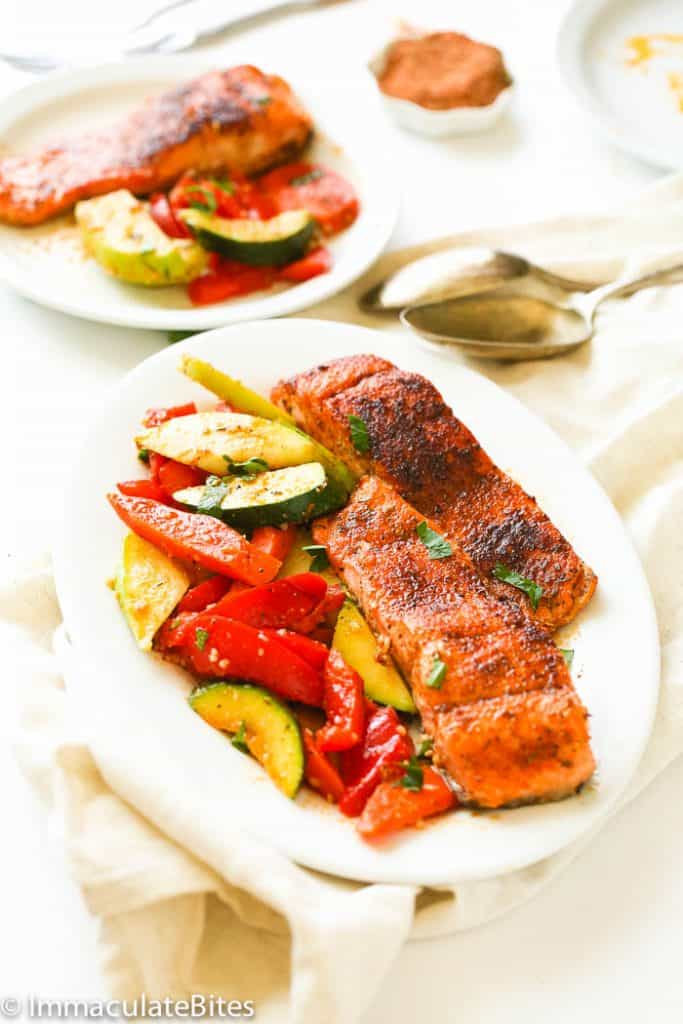
What to Serve with Blackened Salmon?
Level up your dining experience by pairing our sumptuous Blackened Salmon with the following recipes below to enjoy a restaurant-quality meal without spending a fortune.
More Salmon Recipes to Try
- Garlic Butter Salmon in Foil Paper
- Crab-Stuffed Salmon
- Cajun Salmon One Sheet Pan
- Teriyaki Salmon
- Orange Honey Glazed Salmon
Want a simpler yet oh-so-tasty salmon recipe? You might want to try this Oven Baked Salmon with a lemony and spicy kick that makes a fancy mid-week or dinner night meal.
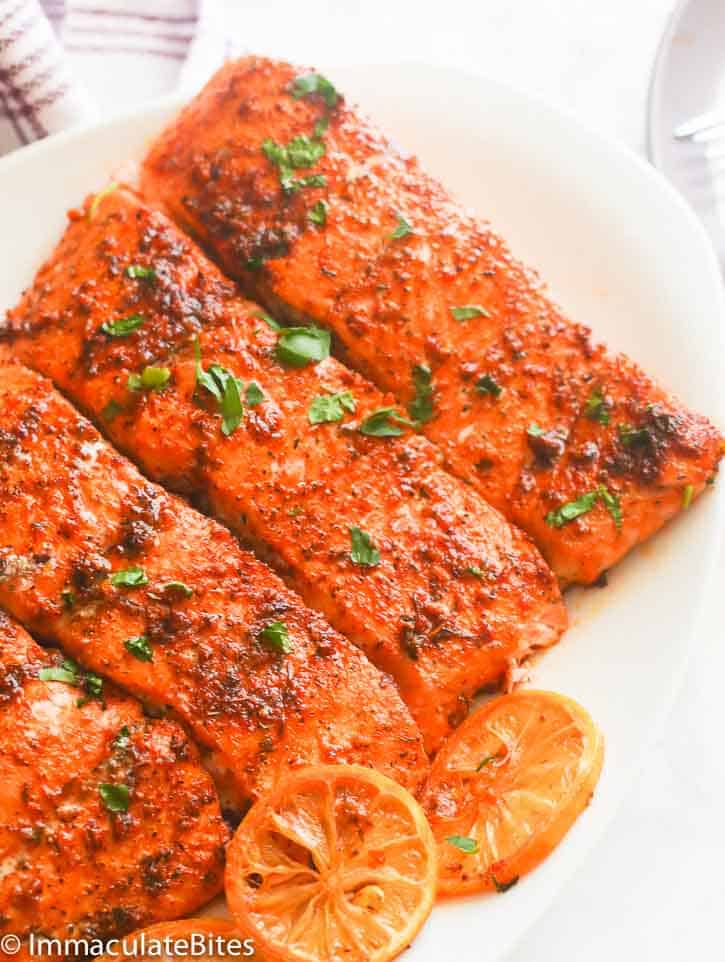
How to Make Blackened Salmon
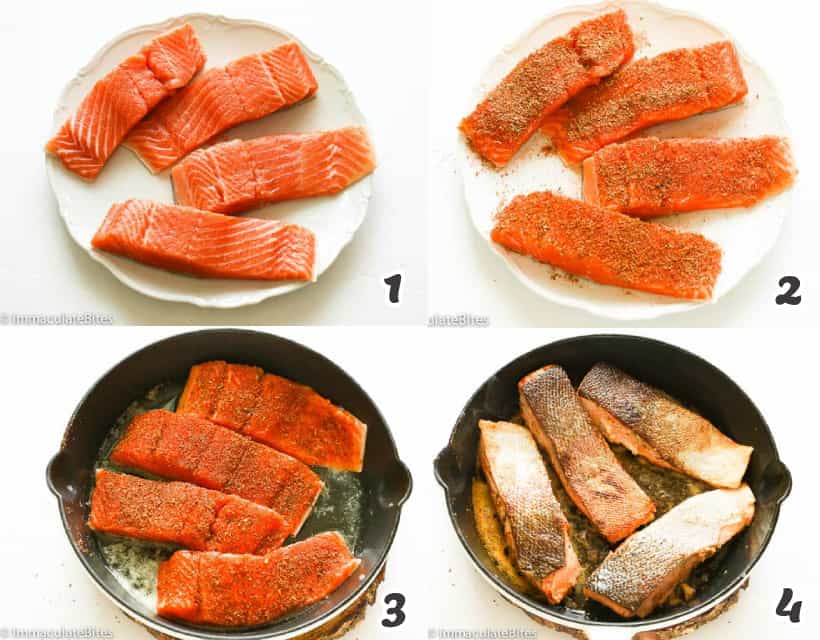
Season and Cook the Salmon
- Season – Brush the salmon lightly with oil, then season with salt, followed by the Creole seasoning. (Photos 1-2)
- Add Butter – Preheat a large, heavy skillet over medium heat for about two minutes, then add butter. For the health-conscious, use cooking oil.
- Sear – Add salmon to the pan. Sear salmon for about 3-4 minutes on each side or until it reaches the desired degree of doneness. (Photos 3-4)
- Serve – Remove and serve with vegetables.
Cook the Veggies
- Blanch – Blanch carrots by cooking them in a pot of boiling salted water for about 3-4 minutes. Drain and set aside.
- Saute – Heat oil over medium heat in a large saute pan. Then add garlic and Creole Seasoning; sauté for about 30 seconds. Add carrots, chayote (if included), and remaining vegetables. Sauté until just tender, tossing often. You may use about a ⅓-½ cup of water or broth to prevent any burns—season with salt.
- Serve piping hot with salmon.
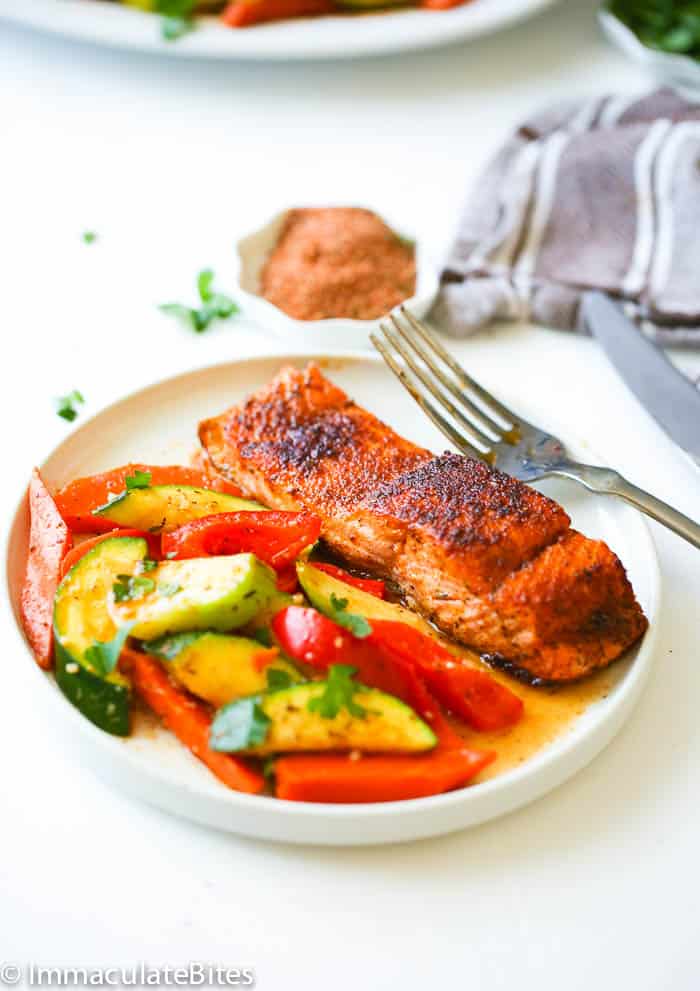
Blackened Salmon
Ingredients
- 3-4 6-ounce or 170 grams each salmon steaks
- cooking oil
- salt to taste
- 4-5 teaspoons (16-20 g) Creole Seasoning (homemade here) per salmon
- 2-3 tablespoons (28-42 g) unsalted butter replace with oil
Sauteed Vegetables
- 1 large carrot, peeled halved lengthwise, then cut on diagonal into ¼-inch-thick slices
- 1-2 tablespoons (14-28 ml) cooking oil
- 2-3 teaspoons (6-9 g) minced garlic
- 1 large red bell pepper cut lengthwise into ½-inch-wide strips
- 1 large zucchini halved lengthwise, then cut on diagonal into ½-inch slices
- 1 chayote halved lengthwise, then cut into diagonal into ½ inch -thick slice
- 2 teaspoons (8 g) Creole seasoning
- ⅓-½ cup water or broth optional
- salt to taste
Instructions
Blackened Salmon
- Brush the salmon lightly with oil, then season with salt, followed by the Creole seasoning.
- Preheat a large, heavy skillet over medium heat for about two minutes, then add butter. For the health-conscious, use cooking oil.
- Add salmon to the pan. Sear salmon for about 3-4 minutes on each side or until it reaches the desired degree of doneness.
- Remove and serve with vegetables.
Sauteed Vegetables
- Blanch carrots by cooking them in a pot of boiling salted water for about 3-4 minutes. Drain and set aside.
- Heat oil over medium heat in a large saute pan. Then add garlic and Creole Seasoning; sauté for about 30 seconds. Add carrots, chayote (if included), and remaining vegetables. Sauté until just tender, tossing often. You may use about a ⅓-½ cup of water or broth to prevent any burns—season with salt.
- Serve piping hot with salmon.
Tips & Notes:
- Always use fresh salmon for the best results. However, frozen salmon works fine as well. Remember to thaw it properly. Do not let it sit on the counter for too long to prevent food-borne bacteria to accumulate.
- It’s best to work with cold salmon (but not frozen) because the butter will stick more to the fish if it’s cold.
- I highly recommend using a cast-iron skillet because we’ll be cooking at high temperature. However, if you don’t have one, stainless steel is the next best thing. You can also use non-stick pans but the perfect “black” or char is not guaranteed.
- Don’t forget to preheat your pan so your salmon fillets won’t stick to the pan.
- Refrain from constantly flipping your fish to achieve the perfectly blackened salmon.
- You’ll know that salmon is done when it reaches an internal temperature of 145°F on its thickest part. Or check if the fillets are easily flakes when you use a fork.
- Don’t forget to blanch your veggies to keep their nutrients and their bright colors.
- Please keep in mind that the nutritional information is a rough estimate and can vary significantly based on the products used in the recipe.
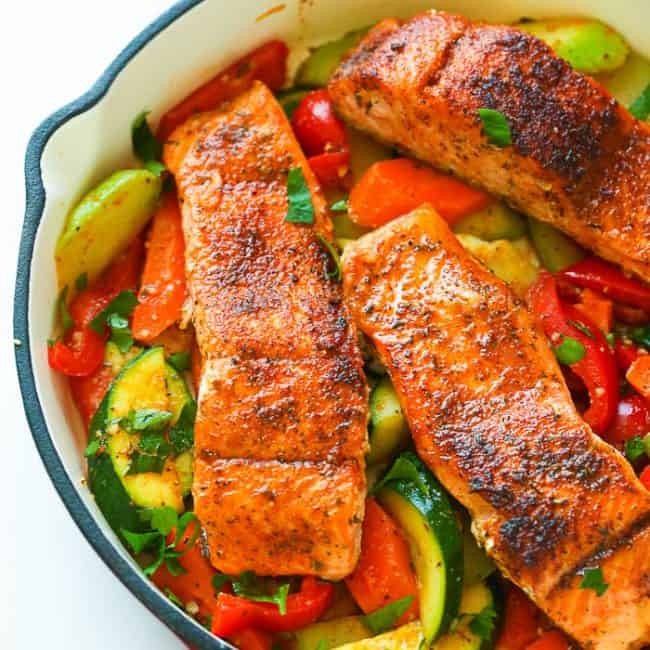

Juliette says
When salmon is “dreaded” . Did you mean to say dredged?
Imma Adamu says
You caught me. Thanks for correcting me. Thank you so much
Ngozi says
I made this today. tasted amazing. Definitely a keeper.
ImmaculateBites says
Hi Ngozi,
So happy to hear this . Thanks so much!!!
Michelle says
Do you think I could make this with Berber instead of creole seasoning?
Michelle says
Sorry- I meant berbere. That was my phone
ImmaculateBites says
Here it is
Shelly says
I made this the other day and was totally in LOVE with it. Very flavorful! I also made a few jars of the creole seasoning to share with family and friends. Thanks for sharing your recipes.
ImmaculateBites says
Awesome! So glad to hear this. Thanks for taking the time to let me know.
charles says
can’t find the recipe for the creole seasoning Imma
ImmaculateBites says
Right here https://www.africanbites.com/creole-seasoning/
charles says
Thank you Imma. I will be having salmon with a difference this evening.
karine says
I can’t wait to try this out. On my way to purchase some of the vegetables- already made the creole seasoning and will never buy store-bought again- YES! Could’t find basil but included everything else. So Flavorfull!!! Thanks Imma, you are my cooking goddess.
ImmaculateBites says
That is such a sweet thing to say. Thank you SO MUCH!!!!